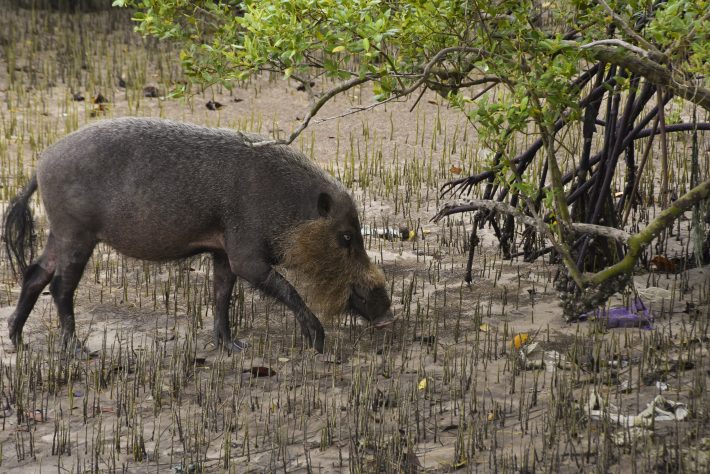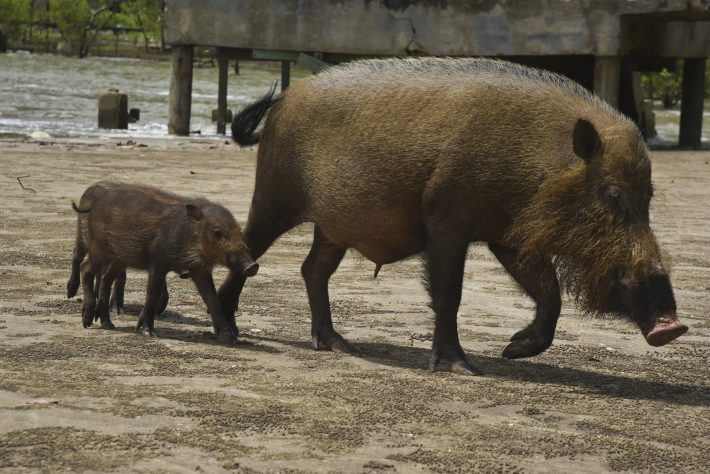Oil palm plantations reshape human hunting
New research shows that oil palm plantations in Borneo are not only affecting ecological landscapes, but also social landscapes. The findings are published in People and Nature.

The wide-reaching impacts of oil palm plantations on land-use and biodiversity are well-documented. But when forest is converted to oil palm, the environmental landscape is not the only thing changing.
Although animal abundances, soil erosion, and ecological interactions can all shift dramatically when oil palm replaces forest, humans also experience changes in livelihoods, cultural practices, and migration. After oil palm comes in, Indigenous communities who have accessed forest resources for millennia often move to cities, and are frequently replaced by migrant workers who tend to the plantations.
Livelihoods may shift from subsistence-based activities like farming, hunting, and gathering to market-based—and sometimes exploitative—industrial oil palm production. As these social and environmental changes occur in tandem, human-environment connections are powerfully reshaped.
New research published today shows that oil palm plantations in Borneo are not only affecting ecological landscapes, but also social landscapes. Indigenous hunters in Sabah, Malaysian Borneo, have traditionally hunted in Sabah’s extensive rainforests. However, now that oil palm plantations cover roughly one-quarter of the entire state, some hunting patterns are changing.
An international research team from Malaysia, the U.K., and the U.S. came together to study the ways that oil palm expansion has affected the millennia-old hunting practices of the largest Indigenous group in Sabah, the Kadazandusun-Murut (KDM) peoples. The team was made up of researchers from the Universiti Malaysia Sabah, Sabah Parks, Danau Girang Field Centre, Sabah Wildlife Department, Cardiff University, the University of Queensland, and UC Berkeley.

The research focused on KDM hunters who primarily hunted their favourite game animal, the bearded pig. In the past, hunters mainly headed to the forests or mangroves to hunt pigs, e.g. with dogs and a spear, on foot with a gun, or using snares. However, now that oil palm is so common, more and more pig hunters are heading to industrial and smallholding oil palm plantations.
As part of this shift, a number of hunters in the study reported that hunting in oil palm is easier than in forests, with some saying that their hunting style involves more waiting rather than active searching for pigs. One hunter shared, “In the plantation you know that the pig will come eventually – it’s only a matter of time,” as compared to the forest where “it’s not as certain even if you hunt all day long – because you will need to walk and only if you cross paths with it will you get it – if you do, you do.”
Hunters also noted that seeing pigs was easier in oil palm plantations. Industrial oil palm plantations are typically planted in rows, with room between rows and generally less understory growth. Bearded pigs, like Eurasian wild boar, are drawn to the abundant oil palm fruits in plantations, and often foray into plantations to forage on these fruits. As a result, the timing and places of the pigs’ arrival in the plantations are sometimes predictable. In fact, there is some evidence that bearded pigs time their arrival in plantations for the hours that oil palm workers are not around – typically in the early evening or at night. Oil palm therefore seems to be influencing both the human and pig sides of the coin when it comes to decision-making.
Some hunters also noted another important distinction between hunting in oil palm and forests – the pig meat tastes different. Several hunters expressed a preference for the taste of pig meat from forest. As one hunter put it, “The pig from the forest is much tastier, it’s more fit. If the pig eats oil palm its fat isn’t as sweet. It’s very rare to meet a pig that’s never eaten oil palm.” Bearded pig meat is often enjoyed at KDM celebrations and feasts, and during everyday meals, and gifting of the meat is an important cultural tradition in KDM communities.
Extensive scientific findings and media coverage have documented the ways in which oil palm agriculture has led to widespread environmental change. But understanding of the ways in which oil palm is affecting human livelihoods and cultural traditions has only more recently been emerging.
Transformations of long-standing social practices—like the 40,000+ year history of hunting bearded pigs in Borneo—speak powerfully to the reach of oil palm beyond its physical footprint. At an exceptionally large scale, oil palm is dramatically altering how landscapes look, who lives in those landscapes, and the kind of livelihoods and leisure that take place there. The diverse ramifications of oil palm are here to stay, and must be understood for long-term social and environmental sustainability.
You can read the full article for free here:
https://besjournals.onlinelibrary.wiley.com/doi/10.1002/pan3.10250
Like what we stand for?
Support our mission and help develop the next generation of ecologists by donating to the British Ecological Society.